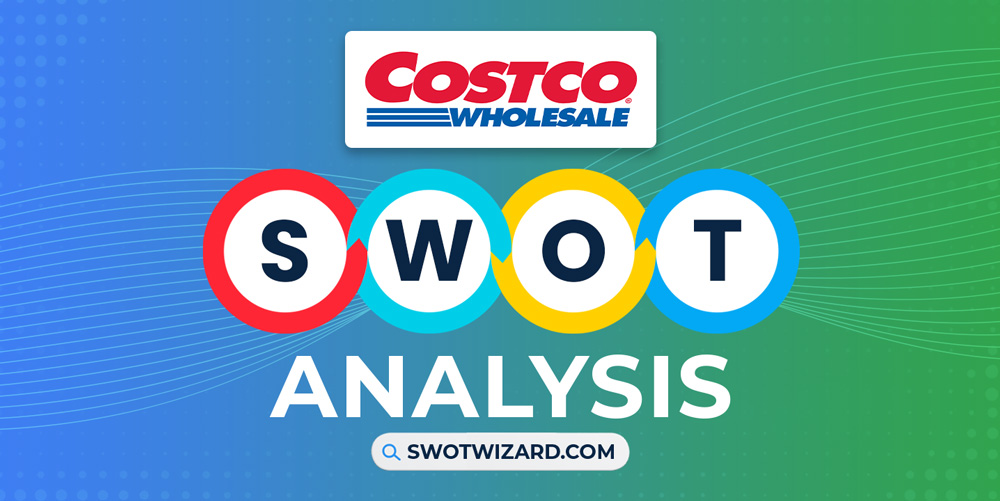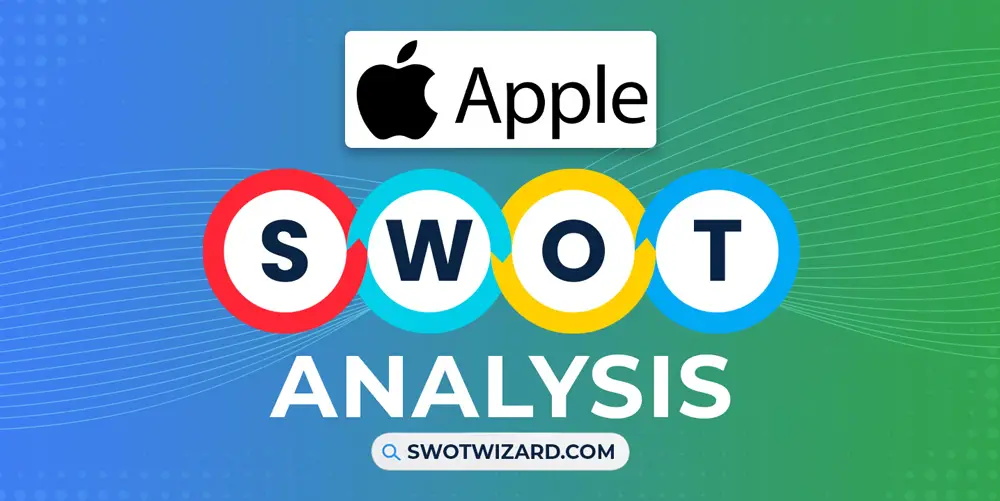Unlike other large retailers, Costco attracted its customers with an offer to sell wholesale directly and provide high discount rates. The company has dominated the US market for years with its simple yet disruptive strategy, and we’ll examine its effectiveness in this article with the Costco SWOT analysis.
Costco: Company Overview
| Company | Costco Wholesale Corporation |
| Industry | Retail |
| Founded | 15 September, 1983 |
| Founders | James Sinegal, Jeffrey Brotman |
| President & CEO | W. Craig Jelinek |
| Headquarter | Issaquah, Washington, U.S. |
| No. of Employees | 304,000+ |
| Annual Revenue | $226.95 billion (FY 2022) |
| Website | costco.com |
Costco opened its 1st warehouse in Seattle in 1983, led by James D. Sinegal and Jeffrey H. Brotman. In 1993, the company merged with The Price Company to become Price/Costco, which was renamed to Costco Companies, Inc in 1997. In 1993, Costco had 206 locations that generated $16 billion.
In 2023, Costco is a multinational corporation operating a chain of membership-based big-box retail. The company headquarters is in Issaquah, Washington in the US. In 2023, the company has a market cap of $215.52 billion and a projected TTM revenue of $237.06 billion.
Product & Services of Costco
Groceries | Appliances | Television And Media | Automotive Supplies | Toys | Sporting Goods | Jewelry | Watches | Books | Apparel | Furniture | Office Supplies
Costco Competitors
Walmart | Amazon | Kroger | Target | Sam’s Club | Walgreens | Home Depot | Tesco | Aldi | Best Buy | Lowe’s
Did You Know?
If the price of any product ends in $0.97 at Costco, it’s on a clearance sale.
Strengths – Costco SWOT Analysis

Large Size: In 2023, Costco has 586 locations spread over 48 states and 493 cities in the US. In 2021, the company had over 828 locations worldwide, with most stores located in the western region. With an average store size of 146,000 square feet and a workforce of 304,000, Costco dominates the grocery market by its sheer size. Due to its size, Costco can access a larger customer base across international markets and has a high resistance to external change drivers.
Powerful Business Strategy: Costco keeps up with its larger competitors with its unique membership and warehouse strategy. Costco keeps its costs down through its efficient supply chain and saves time by skipping additional packaging and sorting, and then it pushes its savings to its members who are willing to buy products in bulk. Costco is so confident of its strategy that the company even loses $40 million annually on its $5 roasted chickens to draw in members. As it provides its members with many tangible benefits, Costco had 58.1 million paid members and 105.5 million cardholders in 2020, and 45% of its members paid $120 for the Gold Star Executive membership.
Driving Big Spending: In contradiction with marketing, Costco makes its money from customers who are willing to spend more on low-cost products. The average Costco shopper in the US is profiled to be a 39-year-old, college-educated Asian-American female who makes over $125,000 annually. As Asian customers are driven by the sunk cost effect, they are more willing to spend on bargain goods than the average and more willing to sign up for membership programs. And Costco’s wholesale concept motivates them to the perfect shopping spree.
A Difference In Operations: Costco achieves high efficiency in its supply chain with its “no touch” approach, saving large on labor costs. From the supplier to its warehouses, the company keeps its products in pallets and then offers them to the customers without taking them out. Costco also uses its warehouse as its retail front, saving money and effort on space and logistics. It further reduces its cost by handling only an average of 3,700 SKUs, requiring less manpower to stock and handle its products.
Wide Product Selection: Costco offers over 21 subcategories of products within its grocery, household essentials, and pets category, with each subcategory having an average of 98 products. It also offers other categories such as optical, pharmacy, insurance, home improvement, travel, and more. By keeping up to 4,000 SKUs per warehouse and using its website, Costco can create an impressive range of value-oriented products that easily attracts a wide customer base with varied preferences.
Weaknesses – Costco SWOT Analysis
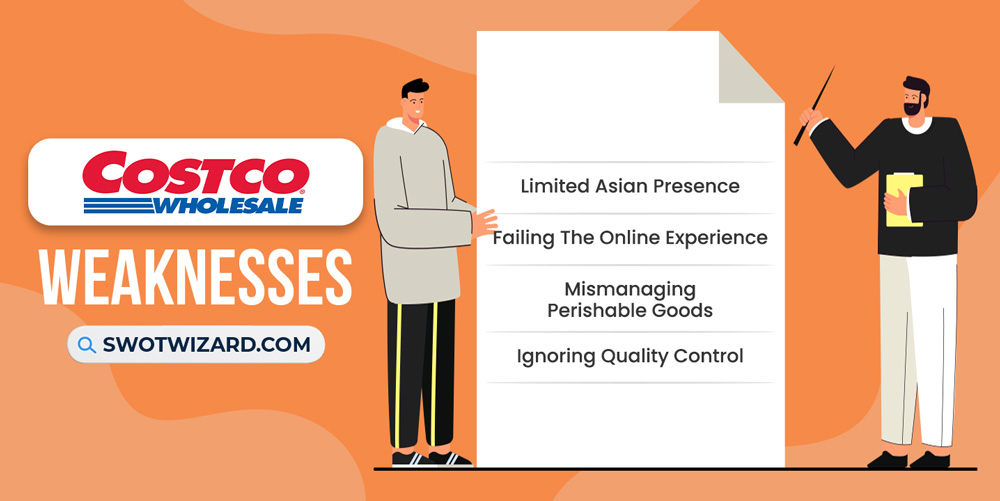
Limited Asian Presence: Costco has little to no presence in the Asian market, with only 16 stores in South Korea, 27 in Japan, and 14 in Taiwan in 2021. Costco’s wholesale, value-oriented goods philosophy is perfect for the Asian market, as customers in these markets look for bargains and cheap products. However, Costco’s supply chain and resourcing don’t allow fast, aggressive expansion. As a result, the company cannot invade its ideal market.
Failing The Online Experience: Costco triggers impulse purchasing in its customers through its membership advantages and physically displaying its products in large lots. However, Costco’s site design fails to create the same effect on its online customers, possibly due to its attempts to emulate the user experience of its competitors. With its slow start and the pandemic influencing virtual sales, Costco has been lagging behind its competitors in its online sales. Misunderstanding the concept of virtual sales has caused the company’s efforts to backfire and slow its growth.
Mismanaging Perishable Goods: Perishable inventory such as groceries comes with the risk of losing value and freshness over time, and Costco is infamous for mishandling its groceries. Costco often throws away food that it cannot sell on the day of production, earning it the 9th ranking on the Center for Biological Diversity’s list of supermarkets pursuing zero waste. The company has no procedures to safely store products that are more prone to rot, such as berries, peaches, bananas, lettuce, and asparagus.
Ignoring Quality Control: Due to selling in large lots and keeping its products in pallets, Costco often skips the necessary quality control needed to maintain and serve products in proper condition. For example, Costco had to recall over 15,000 soups in 2021 due to the product containing sharp plastic shards. The product was the kettle classic clam chowder with uncured bacon, produced by Ivar’s Soup and Sauce Company and sold exclusively by Costco. Without an inspection and announcement by the FDA, Costco did not show any effort to prevent or rectify the situation.
Opportunities – Costco SWOT Analysis

Restructuring The Online Store: Costco can restructure its virtual platform to create and more intuitive UI for its customers and a better UX that pushes them to impulse purchases. The online store can offer curated deals that it can auto-generate and reserve for members and increase the benefits based on tier.
Developing More Private Labels: Costco’s private label Kirkland generates over 30% of profits, and it generated $39 billion in revenue in 2018. Costco uses premium manufacturers such as Duracell, Bumble Bee, Huggies, Starbucks, and others for its high-value private label. However, Costco can sign B2B deals with SME manufacturers for a cheaper private label that can attract shoppers with a stricter budget.
Signing With Valve: The US PC market generated a $67.4 billion revenue in 2022, with around 50 million PC units shipped. However, competitors such as Walmart and Amazon already offer similar services. Costco can go a step further by signing a deal with Valve to sell Steam Decks. In 2022, a survey showed that 94% of the participants had purchased a Steam Deck due to its price and mobility. By selling the Steam Deck, and other upcoming handhelds, Costco can get an edge over the competition.
Threats – Costco SWOT Analysis
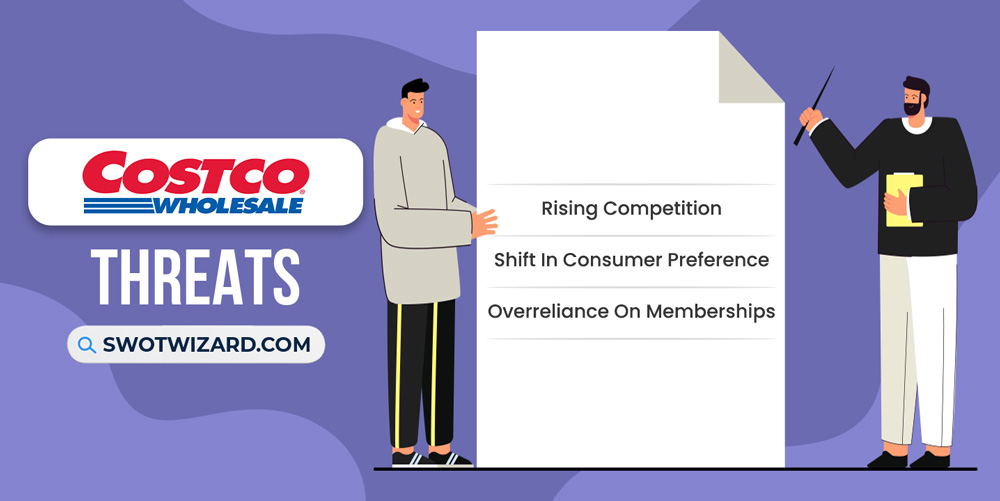
Rising Competition: While Costco had the advantage of being unique in the US groceries market for years, it no longer holds that position. Competitors such as Aldi have taken its operational philosophy and further refined it, generating alarmingly high revenue, market saturation, and customer loyalty. With higher operational efficiency and cheaper but quality private-label products, these rising competitors can steal away a significant portion of Costco’s sales.
Shift In Consumer Preference: Consumer preferences are constantly shifting and can be hard to predict. In 2023, consumers are more willing to spend on quality exclusively and prefer blended experiences. Costco sells in volume and relies on its physical channels for sales, which directly opposes these preferences. Without adapting, Costco can suffer severe losses to its revenue.
Overreliance On Memberships: Costco is heavily reliant on its memberships to generate sales and revenue. The company’s membership strategy has helped it rise as a market leader, but people are gradually taking a stand against subscriptions. If this trend continues, people can eventually consider Costco’s membership as disposable.
[Bonus Infographic] SWOT Analysis of Costco
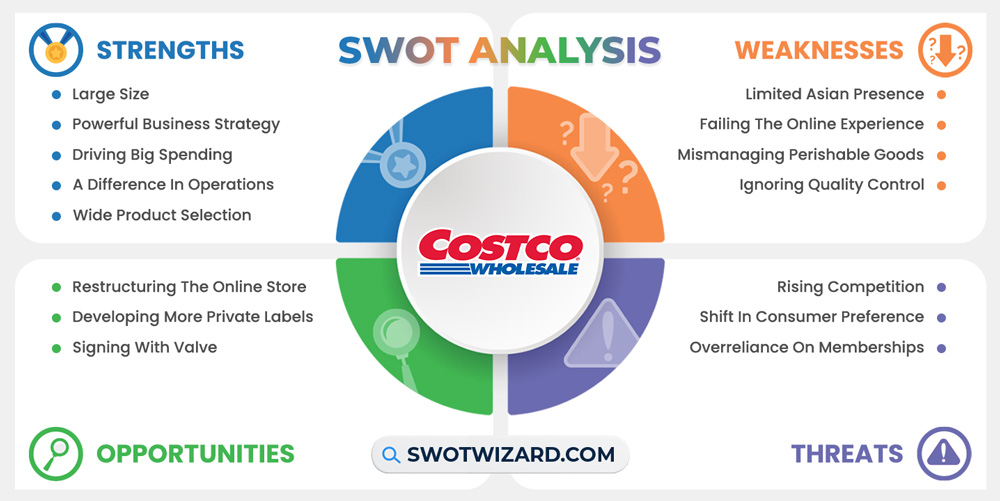
Recommendations for Costco
Costco should consider these suggestions to effectively restructure its infrastructure.
- Costco should rebuild its website.
- It can use AI to power its online deals, and membership benefits.
- Costco can restructure its membership system and app-based.
- The company can make a cheaper private label.
- Costco should open micro-stores to emulate Aldi’s business strategies.
Frequently Asked Questions (FAQs)
What is Costco’s winning strategy?
Costco sells products in bulk and provides high discount rates.
What are the 5 rights of Costco?
Costco promises to provide the right merchandise, at the right place, at the right time, in the right quantities, and at the right price.
Final Words on Costco SWOT Analysis
Costco earned its large market share by entering the market with a unique and disruptive strategy. However, its tactics are now being used and refined by other competitors, and it’s losing ground. If it wants to stay relevant in the grocers’ market, then Costco must make an infrastructural change and analyze its competitors to gain back its advantage.
References
- Wikipedia contributors. (n.d.). Costco. Wikipedia.
- Best, R. (2022, July 25). Who Is the Average Costco Customer? Investopedia.
- Bowman, J. (2020, June 1). Why Costco Could Be a Loser in the E-Commerce Boom. The Motley Fool.
- Britt, H. (2020, July 29). How the Costco Supply Chain Thinks Outside the Big Box. Thomasnet.
- Strategy Study: How Costco’s Unique Business Model Resulted In Global Success. (2023, February 7). Strategy Factory by Cascade.
- Smith, C. (2023, January 8). Costco Statistics and Facts (2023). DMR.

